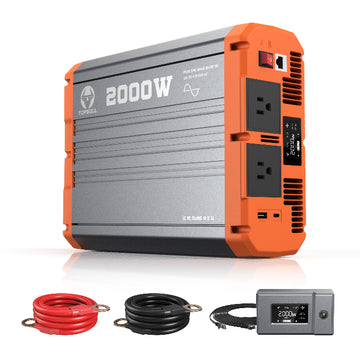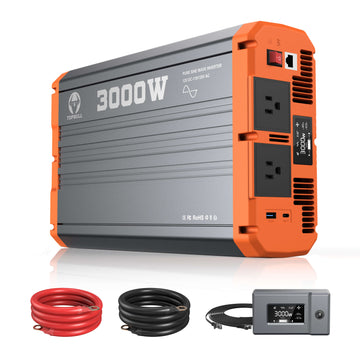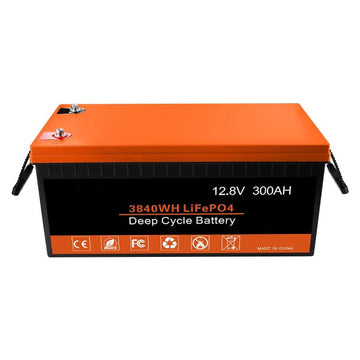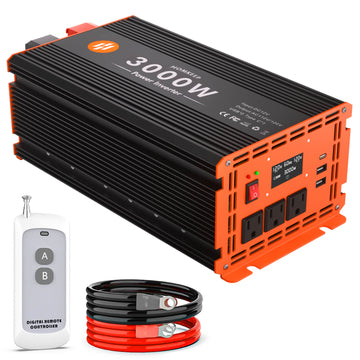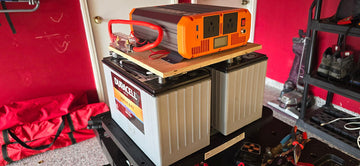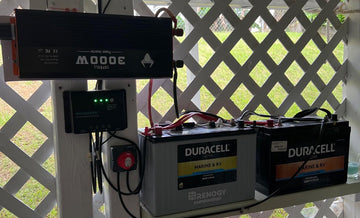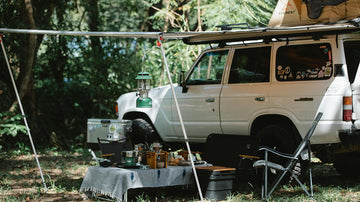If you plan to use 200Ah batteries to power your RV, off-grid cabin, boat, or home backup system, choosing the right inverter is critical. Using the wrong inverter can degrade the system, increase costs, and even damage equipment. In this guide, we'll help you find the best inverter for your needs, whether you're a beginner or an experienced DIY enthusiast.
Understanding the 200Ah battery and the inverter
What does a 200Ah battery mean?
The term “200Ah” means that the battery can deliver 200A continuously for 1 hour or 20A for 10 hours. However, in practice, the amount of energy that can be stored in a battery depends on both voltage and capacity. 12V 200Ah batteries can store up to 2400Wh of energy (200Ah x 12V = 2400Wh).
It is essential to note that discharging a battery's cell to 0% depth of discharge can cause permanent damage to the battery. The actual amount of power available from the battery is affected by the depth of discharge. For example, lead-acid batteries are recommended to be discharged to less than 50%, while lithium batteries can be safely discharged to 80%.
The actual usable energy of a 12V 200Ah lithium battery is: 12V × 200Ah × 0.8 = 1920Wh

The importance of choosing the right inverter for a 200Ah battery
Most electronic devices in daily life require AC power to operate. The inverter is an important bridge to convert the DC power from the battery to AC power. The wrong inverter can not only limit performance, but can also lead to system failures, damage to electronic devices, and even serious safety risks.
Two important parameters for matching batteries and inverters are voltage and power.
1. Voltage Matching
The input voltage of the inverter must match the battery voltage. If you are using a 12V 200Ah battery, it must be matched with a 12V inverter. If the voltage is not, it may cause the device can not start or be damaged.
2. Power Adaptation
Although the power selection of the inverter is mainly affected by the load power, which is not directly related to the battery capacity. However, the battery capacity directly determines the system's range time and load range.
Inverters sized too small to run high-power devices may overheat or shut down under load. Inverters that are too large waste energy at low loads and may consume more idle power than necessary, inefficient for smaller setups.
How to calculate the inverter size for 200Ah batteries?
When selecting an inverter for a 200Ah battery, accurate power matching is key to ensuring efficient system operation. Below is a step-by-step calculation method:
1. Calculate your power requirements
List the devices you plan to run and the power consumption of each device to calculate the total power demand. Next, motorized equipment starts up with additional surge power. Calculate the maximum peak demand at the moment the equipment starts up.
2. Calculate the available energy of the battery
Above, we have calculated that the available energy of a 12V 200Ah battery is 1920Wh. If we use a 24V battery, the available energy is doubled to 3840Wh, and the current loss can be reduced, which is suitable for higher power scenarios.
3. Determine the inverter power
The continuous power of the inverter should cover the total operating power of all the devices, and leave a 20% margin to cope with sudden loads. At the same time, the peak power of the inverter needs to meet the highest start-up power demand to avoid a protection shutdown triggered by inrush current. Most quality inverters have an inrush capacity of twice their rated power.
If you are powering light loads (e.g., lamps, fans, laptops), then a 1000W-2000W pure sine wave inverter is usually ideal. For heavier loads (e.g., microwave ovens, power tools, refrigerators), a 2000W to 3000W inverter is the way to go, but make sure your battery pack and wiring can handle it.
Mistakes to avoid when choosing an inverter
Choosing an inverter may seem simple, but the truth is that many users make some serious mistakes that can lead to decreased performance and even equipment damage. If you are building a system based on 200Ah batteries, avoiding these common mistakes can maximize the value of your system.
Choosing the wrong waveform
There are two common types of inverters: pure sine wave inverters and modified sine wave inverters. Pure sine wave inverters output a waveform close to the mains and are suitable for almost all devices. Modified sine wave has a limited range and is not friendly to sensitive equipment, but it is less expensive.
Some users opt for a modified sine wave inverter to save money, only to find that their electronic devices hum, overheat, or don't work at all. In the end, the cost of repairs far outweighs the difference in the price of the inverter.
Corrected sine wave inverters are only suitable for simple resistive loads (such as incandescent lamps); if you want to run sensitive equipment, you must use a pure sine wave inverter.
Learn about: Do You Need a Pure Sine Wave Inverter?
Ignoring inverter efficiency
Inverters lose some energy in the process of converting direct current (DC) to alternating current (AC), and no inverter is 100% efficient. The lower the efficiency, the greater the waste.
A high efficiency inverter may be 90-95% efficient, while a low efficiency inverter may be as low as 70%. This means that if you are getting the same amount of AC power from an inverter, there is more energy loss with an inefficient inverter. Inefficient inverters add hidden costs.
Mismatched cables and fuses
When current flows from the battery to the inverter, it travels through the cables. If the cables are too thin, they create resistance, which can lead to heat and even fire.
The core function of a fuse is to cut the circuit by blowing when the current limit is exceeded. Fuses with too little capacity will blow frequently in normal use and disrupt the power supply. A fuse with too large a capacity will lose its protective effect and allow the overload current to damage the equipment.
Best inverter for a 200Ah battery
According to the actual power demand of most users, 2000W to 3000W is the most suitable 200Ah battery power range.
2000W 12V pure sine wave inverter
If you want to power smaller loads, such as lights, fans, laptops, small refrigerators, etc., a 2000W inverter is your best choice. A 12V 200Ah battery can store about 2400Wh of power, which is enough to support a 2000W inverter to work for about 1~1.2 hours (assuming full load) to run multiple low-power devices for a long time.

- Pure sine wave output: Provide clear and stable power for precision electronic equipment without damaging home appliances.
- All-round electrical protection: with seven protection functions, overload, overvoltage, undervoltage, high temperature, short circuit, leakage, reverse connection protection, guarding the safety of your battery and equipment.
- Reduce heating problems: upgraded and thickened 100% pure copper wire, and equipped with a dual intelligent temperature control fan, effectively reduces the temperature of the machine.
3000W 12V pure sine wave inverter
If you wish to run more powerful appliances such as coffee makers, induction cookers, power tools, etc., this 3000W 12V off-grid inverter can provide greater output to easily handle short bursts of high power demand. Multiple 12V 200Ah batteries can be connected in parallel to extend the power supply time.

- 3000W continuous power, 6000W maximum power: no pressure to deal with high starting current equipment
- Compatible with most 12V battery systems: suitable for lead-acid, lithium-ion, and other types of batteries
- High conversion efficiency design: minimize losses and improve overall efficiency
The 2000W inverter is ideal for RV, camping, and mobile power systems, while the 3000W is better suited for peak loads or small home off-grid systems.
FAQ
Q: How long will a 200Ah battery last on an inverter?
A: How long the 200Ah battery will last depends on the load of the inverter. At full load, a 1000W inverter connected to a 200Ah battery will run for 2 hours, and a 500W inverter will run for 4 hours.
Q: Can a 200Ah battery run a refrigerator?
A: Typically, most energy-efficient refrigerators consume about 100-200 watts of power, so a 12V 200Ah battery can power a refrigerator for 10 to 20 hours. However, the exact power supply time depends on factors such as the size of the refrigerator, usage, and the efficiency of the inverter.
Q: Can I use a 1000W inverter with a 200Ah battery?
A: Yes, provided that the input voltage of the inverter and the voltage of the batteries are matched. A 12V 200Ah battery can store about 2400Wh of power, which will allow the 1000W inverter to run at full load for about 2 hours, or longer if the load is lighter.

